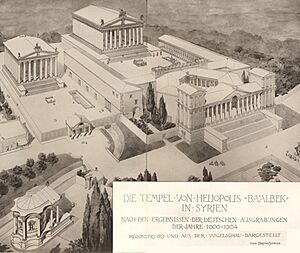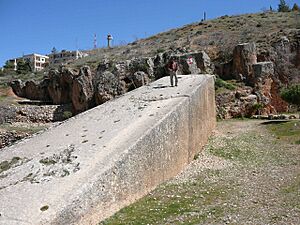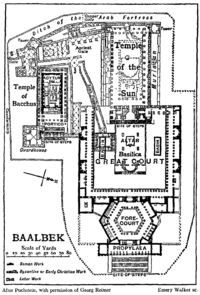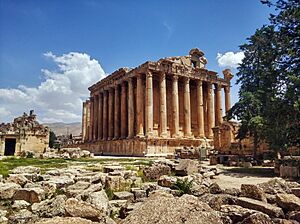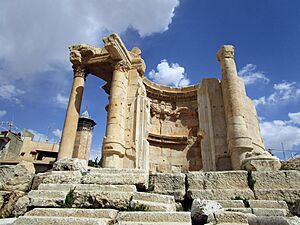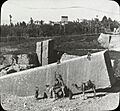Baalbek facts for kids
Quick facts for kids
Baalbek
بَعْلَبَكّ
|
|
|---|---|
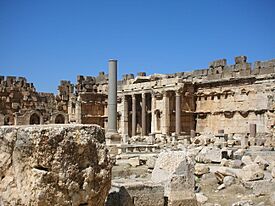 |
|
| Country | |
| Governorate | Baalbek-Hermel |
| District | Baalbek |
| Area | |
| • City | 7 km2 (3 sq mi) |
| • Metro | 16 km2 (6 sq mi) |
| Elevation | 1,170 m (3,840 ft) |
| Population | |
| • City | 82,608 |
| • Metro | 105,000 |
| Time zone | UTC+2 (EET) |
| • Summer (DST) | +3 |
| UNESCO World Heritage Site | |
| Criteria | Cultural: i, iv |
| Inscription | 1984 (8th Session) |
Baalbek (pronounced BAHL-bek) is an ancient city in Lebanon. It's located in the Beqaa Valley, about 67 kilometers (42 miles) northeast of Beirut. This city is famous for its amazing historical sites. These include huge ancient Roman temples and a large mosque from the Umayyad period.
The history of Baalbek goes back at least 11,000 years. It has seen many important times, from prehistoric settlements to the Roman Empire. After Alexander the Great took over in 334 BCE, he called it Heliopolis, meaning "Sun City." The city became very important under Roman rule.
Over time, Baalbek changed with the rise of Christianity and later Islam. It faced attacks from the Mongols and many earthquakes. These events caused the city to become less important. Today, Baalbek is known for the ruins of its Roman temples. These include the Temple of Bacchus and the Temple of Jupiter. In 1984, UNESCO recognized Baalbek as a UNESCO World Heritage site.
Today, Baalbek is a smaller city. It attracts many tourists because of its ancient ruins. However, tourism has faced challenges due to conflicts in Lebanon, like the civil war (1975–1990) and the ongoing Syrian civil war.
Contents
What's in a Name?
The Meaning of Baalbek
The name Baalbek has been discussed for a long time. Some think it means "Baal (Lord) of the Beka" valley. Others believe it means "City of the Sun." One idea is that it comes from "Baal Nebeq," meaning "Lord of the Source" of the Litani River.
Heliopolis: The Sun City
During the Roman Empire, Baalbek was called "Heliopolis." This Greek name means "Sun City." It was named after the local worship of the sun god. The Semitic god Baʿal was often linked to the Greek god Helios or the Roman god Jupiter. Sometimes, it was called "Heliopolis in Syria" to tell it apart from another city with the same name in Ancient Egypt.
A Journey Through Time
Early Beginnings
The area where Baalbek stands has been lived in for about 8,000 to 9,000 years. It had plenty of water from a spring and melting snow. Even though it was in a good spot, it wasn't mentioned in many early records. During the Canaanite times, people worshipped a group of gods: a male god (Baal), his partner (Astarte), and their son (Adon). The Temple of Jupiter likely stands where an older worship site was.
Roman Rule and Grand Temples
The Romans took over Baalbek, calling it Heliopolis. Roman soldiers settled here. The city became part of the Roman territory around 15 BC. It was mentioned by famous writers like Pliny and Strabo.
The Romans built grand temples in Baalbek. The main temple was for Jupiter Heliopolitanus, a mix of the Roman god Jupiter and the local god Baal. This temple was built in the mid-1st century AD. People came from far away to visit this holy site. The Roman temple complex grew from the late 1st century BC until Christianity became popular in the 4th century.
The complex had three main temples:
- One for Jupiter Heliopolitanus (Baal).
- One for Venus Heliopolitana (Ashtart).
- A third for Bacchus.
These temples were some of the largest in the Roman world.
Changes with Christianity
When Christianity spread, Baalbek became a place of conflict. Early Christian writers criticized the local pagan practices. Around 297 AD, an actor named Gelasinus was killed for converting to Christianity. Later, Constantine, who was not yet Christian, ordered the demolition of the goddess's temple. He built a church in its place.
The Temple of Jupiter was already damaged by earthquakes. It was torn down around 379 AD and replaced by another church. Stones from the pagan temples were used for new buildings. In the 6th century, eight large columns from the complex were sent to Constantinople (modern-day Istanbul). They were used to rebuild the Hagia Sophia church.
Medieval Times and Conflicts
Muslim armies took over Baalbek around 634 AD. The ruined temple complex was turned into a fortress called "al-Qala" (The Fortress). However, it was attacked and damaged by the caliph Marwan II in 748.
Baalbek was part of the Damascus region under different Islamic rulers. It was attacked by the Byzantines and later by the Seljuk Turks. In 1075, the Seljuks took control. The city's fortress was used as a prison for Crusaders at one point. In 1171, these prisoners took over the castle but were later defeated.
Baalbek suffered from three major earthquakes in the 12th century. The one in 1170 damaged the city walls. Even though they were repaired, the city faced more sieges and changes in leadership. The Mongols took Baalbek in 1260 and destroyed its defenses. Later, the Egyptian sultan Qutuz defeated the Mongols. Most of the city's mosque and fortress buildings that still stand today were built in the late 1200s.
Modern Era and Discoveries
In 1516, the Ottomans took over Baalbek. European travelers began to visit the impressive ruins in the 16th century. They were amazed by the huge temples. The 1759 earthquakes caused more damage to the city.
In 1898, German Emperor Wilhelm II visited Baalbek. He saw the magnificent Roman ruins and the poor condition of the modern town. He sent an archaeological team to study the site. They worked until 1904 and found many important things. Later excavations found pottery from the Persian period (6th–4th centuries BC).
In 2014, a team found an even larger stone in a nearby quarry. It measures about 19.6 x 6 x 5.5 meters (64 x 20 x 18 feet). It is estimated to weigh about 1,650 tons. This makes it possibly the largest ancient stone block in the world.
Recent History
Baalbek was connected to a railway in 1902, linking it to Beirut and Aleppo. However, train service stopped in the 1970s due to the Lebanese Civil War.
The Roman ruins are now home to the Baalbeck International Festival, a famous arts event. In the 1970s, a movement to help Lebanon's Shia community started in Baalbek. This led to the creation of the Amal Militia. Later, the group that became Hezbollah also grew in Baalbek.
In 2006, during the Lebanon War, Israeli forces raided Baalbek. They were looking for captured soldiers. The city and surrounding areas were hit by air strikes. After the conflict, efforts began to repair the damaged historic sites.
Exploring the Ruins
The Baalbek temple complex was built from local stone, mostly white granite and marble. Over many years, earthquakes, religious conflicts, and the reuse of stones have damaged the temples. For example, the Qubbat Duris, a 13th-century Muslim shrine nearby, was built using columns from Baalbek.
The complex sits on a huge raised platform. This platform was built with about 24 massive stones, each weighing around 300 tons. The most famous part is the "Three Stones" (Trílithon) in the western wall. Each of these three stones is over 19 meters (62 feet) long, 4.3 meters (14 feet) high, and 3.6 meters (12 feet) wide. They weigh about 800 tons each! Another huge stone, called the Stone of the Pregnant Woman, lies unused in a nearby quarry. It weighs about 1,000 tons. A fifth, even larger stone (1,200 tons) is also in the same quarry.
The Propylaea: Grand Entrance
The temple complex was entered from the east through the Propylaea, a grand entrance with a wide staircase. Most of its columns have fallen.
The Great Court
Behind the Propylaea is a hexagonal forecourt, then the large rectangular Great Court. This court covers about 3 to 4 acres. It had a main altar for offerings and basins for washing. It was surrounded by columns, but only six out of 128 remain standing.
The Temple of Jupiter
The Temple of Jupiter is at the western end of the Great Court. It was built on a platform 7 meters (23 feet) high. This temple was once surrounded by 54 columns. Earthquakes and people taking stones for other buildings have damaged it. Today, only six columns remain standing on its south side. The large stone blocks in the temple's upper parts weigh up to 60 tons each. One corner block weighs over 100 tons. It's still a mystery exactly how the Romans lifted such heavy stones so high.
The Temple of Bacchus
The Temple of Bacchus is the best-preserved building in the complex. It was likely finished around 190 AD. This temple is known for its beautiful carvings and sculptures. It is surrounded by 42 columns, each almost 20 meters (66 feet) tall. The entrance was once very well preserved, but an earthquake in 1759 caused damage. The inside of the temple has a long main hall and a raised sanctuary. During medieval times, the temple was used as a strong tower within the city's defenses.
The Temple of Venus
The Temple of Venus, also called the Circular Temple, was added in the early 3rd century. It was later destroyed and replaced by a church. It was used as a Greek Orthodox church until the 18th century.
City Walls and Fortifications
The ancient walls of Heliopolis were almost 4 miles (6.4 km) long. Many of the walls and towers around the complex today were rebuilt in the 13th century by the Mamluk sultan Qalawun. This happened after the Mongol army destroyed earlier defenses.
Climate in Baalbek
Baalbek has a mediterranean climate. This means it has hot, dry summers and cool, sometimes snowy, winters. Autumn and spring are mild and get a fair amount of rain. It's one of the drier parts of Lebanon, with about 450 mm (18 inches) of rain each year. Most of the rain falls between November and April.
| Climate data for Baalbek | |||||||||||||
|---|---|---|---|---|---|---|---|---|---|---|---|---|---|
| Month | Jan | Feb | Mar | Apr | May | Jun | Jul | Aug | Sep | Oct | Nov | Dec | Year |
| Mean daily maximum °C (°F) | 7.1 (44.8) |
8.8 (47.8) |
13.5 (56.3) |
18.3 (64.9) |
23.5 (74.3) |
28.4 (83.1) |
31.6 (88.9) |
31.7 (89.1) |
28.3 (82.9) |
22.9 (73.2) |
15.8 (60.4) |
10.3 (50.5) |
20.0 (68.0) |
| Daily mean °C (°F) | 3.4 (38.1) |
4.7 (40.5) |
8.8 (47.8) |
13.3 (55.9) |
18.3 (64.9) |
22.3 (72.1) |
25.2 (77.4) |
25.3 (77.5) |
22.3 (72.1) |
17.8 (64.0) |
11.2 (52.2) |
6.2 (43.2) |
14.9 (58.8) |
| Mean daily minimum °C (°F) | −0.1 (31.8) |
0.9 (33.6) |
4.1 (39.4) |
8.0 (46.4) |
12.5 (54.5) |
16.1 (61.0) |
19.0 (66.2) |
19.2 (66.6) |
16.8 (62.2) |
13.4 (56.1) |
7.4 (45.3) |
2.7 (36.9) |
10.0 (50.0) |
| Average precipitation mm (inches) | 71 (2.8) |
67 (2.6) |
54 (2.1) |
34 (1.3) |
26 (1.0) |
4 (0.2) |
1 (0.0) |
2 (0.1) |
6 (0.2) |
23 (0.9) |
45 (1.8) |
56 (2.2) |
389 (15.2) |
Famous People from Baalbek
- Saint Barbara (273–306)
- Qusta ibn Luqa (820–912), a smart person who worked in math and translating.
- Bahāʾ al-dīn al-ʿĀmilī (1547–1621), a Lebanese-Iranian expert in many fields like philosophy, math, and astronomy.
- Khalil Mutran (1872–1949), a poet and journalist.
- Juliana Awada, former First Lady of Argentina.
Sister Cities
Baalbek has "twin" or "sister" cities around the world, which means they have special friendly relationships:
 Bari, Italy
Bari, Italy L'Aquila, Italy
L'Aquila, Italy Thrace, Greece
Thrace, Greece Yogyakarta, Indonesia
Yogyakarta, Indonesia
Images for kids
-
Panorama, around 1870, by Félix Bonfils
See also
- Cities of the ancient Near East
- List of colossal sculpture in situ
- List of megalithic sites



